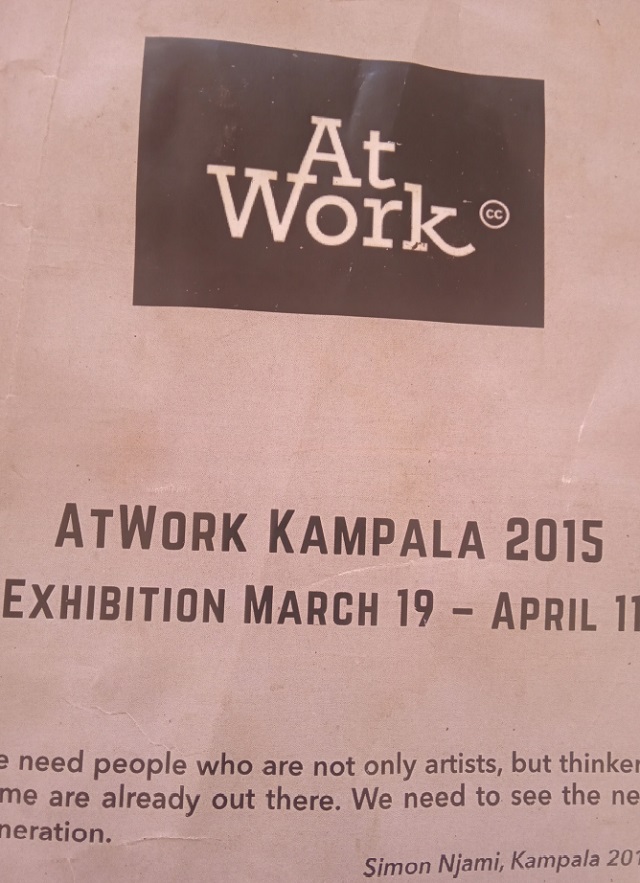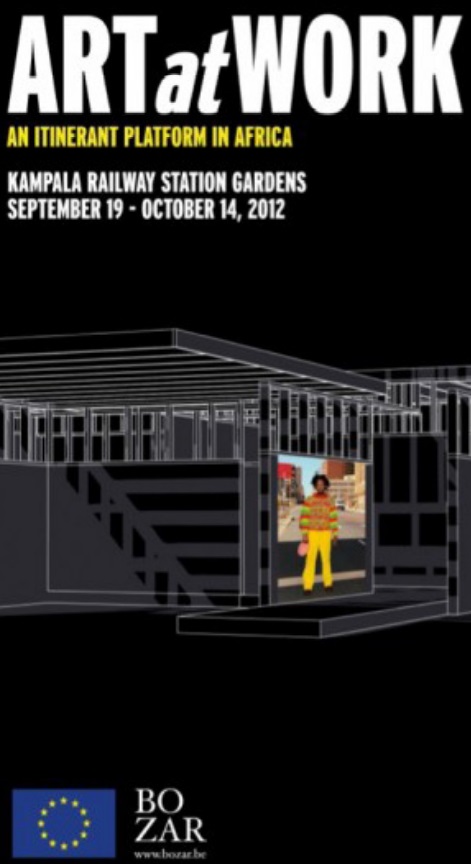
The workshop inspired new ways in the process of art and exhibitions on the local at scene.
Kampala, Uganda | DOMINIC MUWANGUZI | The experimental project Atwork conceived from the itinerant workshop Visionary Africa- Art at Work that travelled from Tripoli to several African capitals including Ouagadougou, Addis Ababa, Cairo and Kampala, sparked interesting conversations about art during itsitinerary. In Kampala, where the project will celebrate its tenth anniversary this year since its destination here, it is responsible for overturning perceptions on the process of art and exhibitions: inviting the idea of critical thinking in knowledge acquisitionand the creative processes, particularly among artists. Within this transitioning, the concept of art in public space and unconventional art spaces became popular in Kampala, with exhibitions seeking new audiences and validity from ordinary citizenry. Since then, there has been emerging trends among certain groups of artists to create art with the backdrop of critical thinking and therefore provide enduring conversations on their artistic practice.
 In the months that followed the Workshop with its emblematic Pavilion purposefully constructed in the public space- the open square opposite the Uganda Railway station- the first Art festival was inaugurated in Kampala.The Kampala Contemporary Art Festival 2012 built its concept of 12 Boxes Moving, from the idea of creating new audiences for art that hinged on the Workshop’s brilliant theory of designing exhibitions outside the traditional places of consecration. Yet, such undertaking seemed to want to shed light on what type of relationship exists between art and State.The location of the 12 shipping containers as exhibition space for art within Kampala City Center; a business hub but also a site for the Judiciary, Parliament and Executive, brought into perspective how the State perceives art. Until then, the State had- and perhaps still continues to do so-interpreted art as a political project. As such its involvement with art in the city had been largely focused on promotion of Culture and Identity. This is very much visible to the monumental sculptures that dot the city. These convey the political history of the country and the identity of the State.
In the months that followed the Workshop with its emblematic Pavilion purposefully constructed in the public space- the open square opposite the Uganda Railway station- the first Art festival was inaugurated in Kampala.The Kampala Contemporary Art Festival 2012 built its concept of 12 Boxes Moving, from the idea of creating new audiences for art that hinged on the Workshop’s brilliant theory of designing exhibitions outside the traditional places of consecration. Yet, such undertaking seemed to want to shed light on what type of relationship exists between art and State.The location of the 12 shipping containers as exhibition space for art within Kampala City Center; a business hub but also a site for the Judiciary, Parliament and Executive, brought into perspective how the State perceives art. Until then, the State had- and perhaps still continues to do so-interpreted art as a political project. As such its involvement with art in the city had been largely focused on promotion of Culture and Identity. This is very much visible to the monumental sculptures that dot the city. These convey the political history of the country and the identity of the State.
The partnership between Bayimba Cultural Foundation and Kampala City Council Authority (KCCA) to host this seminal workshop in Kampala, very much echoed the interpretation of art as a cultural tool used to fulfill the desires of the State, and not necessarily promote society’s advancement and progression. However, the invitation of different participants from a broad spectrum of arts and culture locally, suggested a genuine interest to realize the latter ideal. Ironically, the event happened at the height of the debate on who owns the City: Is it KCCA with its mandated right under the 2010 Constitution Amendment Act of parliament or the citizenry who work, live and pay taxes in the Capital? Albeit such query, KCCA embraced a partnership with the organizers of the Kampala Contemporary Art Festival (KLA ART 012) to have the shipping containers occupy specific spaces across the City for public display of art. In 2014, such partnership was renewed with the KLA ART 014’s Boda- Boda- project that had the mobile motorcycle taxis traverse the city with artworks ferried on their backs. The Boda-Boda therefore became a moving exhibition; visiting the locales of a particular type of audience, instead of the other way round.
This shift from the traditional showcase of art to unconventional exhibitions over the years has undoubtedly provoked artists and curators to think in creative ways. Exhibitions in Kampala, regardless of the space they occupy, have today become more intentional with the type of art submitted for display. This has been largely achieved by engaging the artist into the process of art production that extends beyond creating an artwork but thinking how it will be received by the public. The Kampala Contemporary Art Festival has always offered mentoring sessions for participating artists in each edition of the Festival. Conversely, the first alumni of the Artwork workshop 2015, have since evolved into formidable characters on the local art scene and beyond. Artists like Emmy Mali, Ian Mwesiga, Hellen Nabukenya, Stacey Gillian and Moses Serubiri are today contributing to global conversation on Contemporary Art from Africa through their practice. These names in their respective right have therefore succeeded in metaphorically “crossing door sills” like alluded to in the first workshop.
Art at Work is an experiment, a proposition and therefore it doesn’t impose a system of practice on artists. Otherwise, it presents ideas that are subject to change and criticism depending on the art ecology of a specific destination. This is important because although African countries may generally be suffering from the same problem of lack of developed institutional and artistic infrastructures, they definitely differ in terms of how these problems are being addressed. As such, in Kampala where the oldest art school exists in Eastern and Central Africa, there is no linkage between what is taught here (an imposed modernist western system of art practice) to what is happening in the globalized art world. A timely ‘intervention’ like the workshop is a brilliant platform to inspire critical thinking in knowledge acquisition either on or outside the school campus.
****
The project is a brainchild of renowned Ghanaian- British Architect David Adjaye and Independent art curator Simon Njami
 The Independent Uganda: You get the Truth we Pay the Price
The Independent Uganda: You get the Truth we Pay the Price


